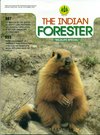People’s Perception on Human–Wildlife Conflict in a Part of Kailash Sacred Landscape–India and Strategies for Mitigation
DOI:
https://doi.org/10.36808/if/2018/v144i10/139588Keywords:
Horizontal Transect, Kailash Sacred Landscape, Wildlife Conflict, Western HimalayaAbstract
In the selected horizontal transect of Pithoragarh District, crop damage by wildlife impacts the livelihood of local people. Authors interviewed randomly 317 villagers living in the lower part of KSL, India. Respondents perceived that HWC have resulted in significant shifts in crop pattern, food shortages, and poverty in the study area. 89% per cent of farmers reported that wild animals significantly contributed to the shortages of food for their family. Most of the interviewed villagers suffered major financial losses annually due to crop damage by Rhesus Macaque (Macaca mulatta), Wild Pigs (Sus scrofa), Indian Crested Porcupine (Hystrix cristata), Hanuman Langur (Semnopithecus entellus), and Barking Deer (Muntiacus muntjak). The farmers were aware of several locally used management options, which they suggested could be used to reduce the negative impacts of the conflicts. The authors found that the significant effect of HWC on social, economic, and environmental well-being of the community of KSL-India.References
Brandt S.A., Spring A., Hiebsch C., McCabe J.T., Tabogie E., Diro M., Wolde-Michael G., Yntiso G., Shigeta M. and Tesfaye S. (1997). The tree against hunger: enset-based agricultural systems in Ethiopia. American Association for the Advancement of Science, Washington, D.C.,USA.
Dange M., Jassica R. and Mehari A. (2015). Farmers perceptions about the impact of human-wildlife conflict on rural livelihood and natural resource management efforts in ChehaWoreda of Guraghe Zone, Ethiopia. Inter. J. Agriculture and Extension, 3:003-090. ISSN 2329-9797
Dickman A.J. (2008). Key determinants of conflict between people and wildlife, particularly large carnivores, around Ruaha National Park, Tanzania. Dissertation, University College London and Institute of Zoology, Zoological Society of London, United Kingdom.
Distefano E. (2005). Human-Wildlife Conflict worldwide: collection of case studies, analysis of management strategies and good practices. FAO, Rome.
Else J.G. (1991). Nonhuman primates as pests. Pages 115–165 in H. O. Box, editor. Primate responses to environmental change. Chapman and Hall, London, United Kingdom.
Fuentes A. (2006). Human–nonhuman primate interconnections and their relevance to anthropology. Ecological and Environmental Anthropology, 2:1-11.
Heidi E.K., Paul D.C., Joseph D.F., Rolf J.P. and Barbara A.K. (2013). Factors Affecting Perceptions of Human–Wildlife Interactions in Residential Areas of Northern New York and Implications for Conservation. Human Dimensions of Wildlife, 14:102-118.
Hill C.M. (2004). Farmers' perspectives of conflict at the wildlife–agriculture boundary: some lessons learned from African subsistence farmers. Human Dimensions of Wildlife, 9:279-286.
Hoare R.E. (1992). The present and future use 76 Human– Wildlife Interactions 8(1) of fencing in the management of larger African mammals. Environmental Conservation, 19:160-164.
ICIMOD (2010). Kailash sacred landscape conservation initiative: target area delineation report. ICIMOD, Kathmandu KSLCDI Feasibility Report (2010). Kailash Sacred Landscape Conservation Initiative, Feasibility Assessment Report. GBPHID Almora, ICIMOD, Katmandu. Unpublished Report
Lamarque F., Anderson J., Fergusson R., Lagrange M., OseiOwusu Y. and Bakker L. (2009). Human–wildlife conflict in Africa: causes, consequences and management strategies. Food and Agriculture Organization Forestry, Paper 157. United Nations, Rome, Italy.
Muruthi P. (2005). Human–wildlife conflict: lessons learned from African Wildlife Foundation's African Heartlands. Working Paper. African Wildlife Foundation, Nairobi, Kenya.
Ogra M. (2008). Human-wildlife conflict and gender in protected areaborderlands: a case study of costs, perceptions, and vulnerabilitiesfrom Uttarakhand (Uttaranchal), India. Geoforum, 39(3): 1408-1422.
Robert J.Z., Antonio T., Marc J.M., Mingcheng W., Krishna P.O. and Jianchu Xu. (2014). Projected climate change impacts on spatial distribution of bioclimatic zones and ecoregions within the Kailash Sacred Landscape of China, India, Nepal. Springer Science Business Media Dordrecht.
Sprague D.S. and Iwasaki N. (2006). Coexistence and exclusion between humans and monkeys in Japan are either really possible? Ecological and Environmental Anthropology, 2:30-43.
Weladji R.B. and Tchamba M.N. (2003). Conflict between people and protected areas within the Bénoué Wildlife Conservation Area, North Cameroon; Wildlife Conservation Area, North Cameroon. Oryx, 37: 72-79.
Downloads
Downloads
Published
How to Cite
Issue
Section
License
Unless otherwise stated, copyright or similar rights in all materials presented on the site, including graphical images, are owned by Indian Forester.





